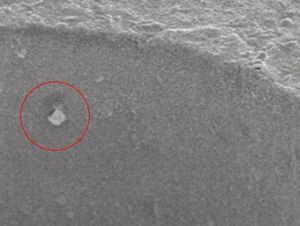Femtosecond/Picosecond Seeder for Material Processing
Micromachining using femto- and picosecond laser pulses
- High peak power of ultrashort laser pulses ablates material
- Direct vaporization with no molten edges
- Methods: Scribing, cutting or drilling
- Materials: Glass, solar cells, wafers, metal sheets, medical devices or polymers
- Reliable seed lasers are required for stable applications
Material structuring and ablation using ultrashort pulses are closely related processes. Short laser pulses of picosecond (ps) or femtosecond (fs) duration with extremely high peak power and extremely high energy density lead to a vaporization of the irradiated material without passing through a liquid phase (it directly sublimates). Very little molten material results from this process and the heat affected zone is minimized. Each laser pulse produces a small depression that is typically only a few micrometers in diameter and depth. Also transparent materials like glass can be processed very efficiently with this process using two-photon absorption processes.
Standard tool in industrial material processing
Nowadays ultrafast lasers have become a standard tool in industrial material processing. Scribing, cutting or drilling various materials like glass, solar cells, wafers, metal sheets, medical devices or polymers.
Depending on the application and material to be processed either ps or fs pulses with repetition rates between 100 kHz and a few tens of MHz are used. The required pulse energy typically is between 1 and 100 µJ and the industrial wavelength standard has become 1 µm (and frequency doubled/tripled versions).
In order to generate these laser parameters typically hybrid combinations of a fs/ps fiber seeder and high power solid state (or fiber) amplifier are utilized. This combination has the advantage that the complex and stable generation of fs/ps seeder pulses can be decoupled from the also complex generation of high energy pulses. Since the spectral bandwidth of the amplifier medium is typically below 1 nm, one of the main challenges for the seeder is to provide an excellent wavelength stability in addition to constant pulse duration and power stability.
Fiber based seeders are nowadays available at all wavelengths between 1030 and 1070 nm (suited for all major solid state amplifiers), pulse durations of 400 fs to 10 ps suitable for all major micro machining applications) and typical repetition rates of 20 - 30 MHz.

